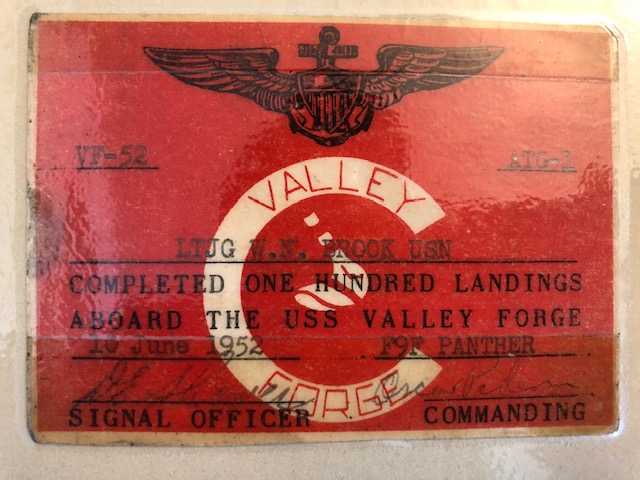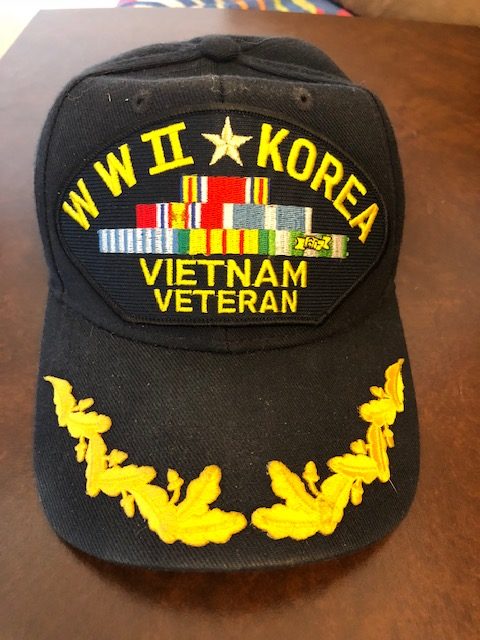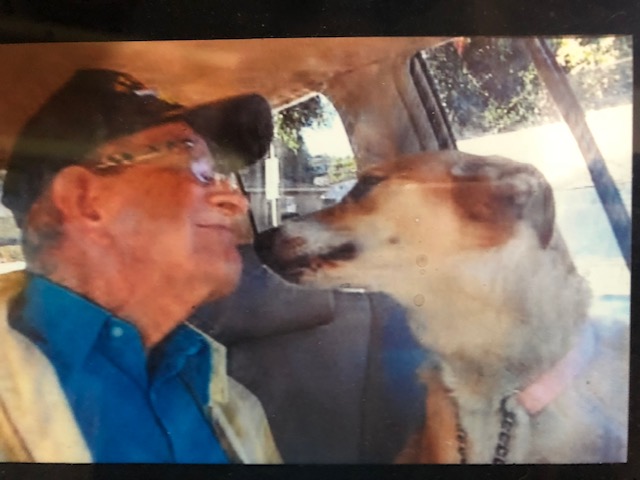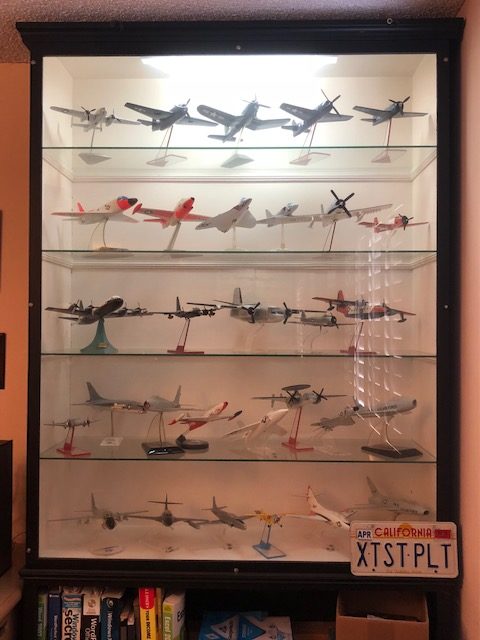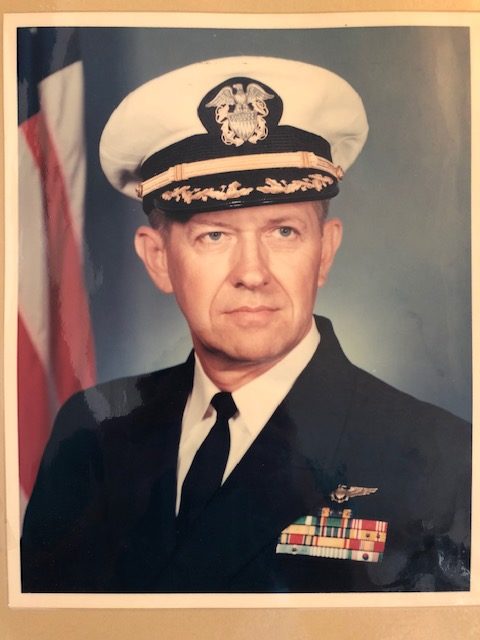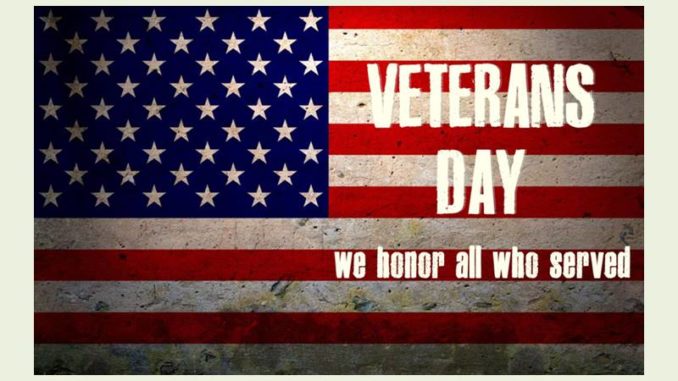
From the desk of Sandy Lippe: Tom Brook did not set out to write a love letter to his dad, William N. Brook, Jr, a retired Navy Commander. However, the story of Bill Brook’s life in the military is really written as a love letter from son to father this Veteran’s Day.
Bill Brook was born in LaGrange, Georgia, in 1924 and was raised in Florida. As a skinny, sixteen year old kid nicknamed in the military as “Chicken Legs,” Bill lied about his age and got his mom to sign off on his enlistment papers for the Army in May of 1940. Described as dirt poor, Bill loved the Army with its three meals a day and rose through the ranks to eventually become a test pilot, a college graduate. He rubbed elbows with fellow servicemen like astronaut Neil Armstrong and Alan Bean, another astronaut also on the Apollo 12 flight who walked on the moon. According to Bill’s caretaker for the last two years, Raul Padayao, Jr.,”Pops told Neil Armstrong he would be the first man to walk on the moon because Neil had an all-American name.” Pops is Raul’s affectionate name for his hero, Bill.
Serving in three wars, World War II, Korea, and Vietnam, Bill was first sent to Panama Canal after basic training. “It was so hot and humid, I had to change my uniform three times a day.” Rotating back to the states in 1943, Bill was an eighteen year old drill sergeant. Then he became attached to a combat engineer battalion specializing in building airfields. His unit later participated in the Battle of Saipan in June 1944. According to his son Tom, “Dad’s job was rebuilding airfields for our B-29 bombers. Dad watched a dogfight between two Navy Hellcat fighters and a Japanese Zero which kindled his interest in flying even more.”
The end of the war found him building an airfield on le Shima, a tiny island next to Okinawa, where famous war correspondent Ernie Pyle was killed by a Japanese sniper in 1945. Bill saw Japanese transport planes land at le Shima with Japanese officials who flew on to Manila in American planes to discuss the surrender of Japan on September 2, 1945. After the war ended, Bill was discharged and returned to Florida. He earned money as a Greyhound bus driver, passed his high school equivalency, enrolled in University of Miami and in 30 months earned an accounting degree. Many veterans “worked and studied with a vengeance,” according to Bill’s son, and their young instructors were just pages ahead of the students/veterans who filled the classrooms, thanks to the G I bill.
Too old for flight training for the Air Force but under the limit for the Navy, Bill began his Navy flight training in 1948 or 1949. When the Korean War started in June of 1950, Bill was an ensign and fully trained jet fighter pilot in a squadron flying the F-9-Fs. The squadron deployed to Honolulu and in a Tom Cruise move, Bill buzzed the airport and barely avoided getting into serious trouble. Later on he served two tours flying his fighter jet off a carrier bombing North Korean and Chinese positions.
“In September 1951, when he was a shipmate of Neil Armstrong, Armstrong was returning from a bombing run and flying through the Valley of Death as my dad called it, Neil clipped off part of his wing on an anti-aircraft cable that the Koreans strung across the valley floor. Neil was avoiding enemy fire. He nursed his plane close to a Marine base and ejected. My dad flew air cover for Neil until he was rescued by the Marines nearby. Dad was awarded the Navy Flying Cross for his time in Korea for his bravery and inspiration to the other pilot,” Tom said. After Korea, Bill stayed in the Navy to spend two years on exchange duty with the Air Force in Las Vegas where he trained every day with Air Force ace fighter pilots of Korean War fame. “All we did was fly and then drink beer,” Bill told his sons. “He loved that duty. Because of Dad’s elite training, he became arguably the best fighter pilot in the Navy.” Moved to the Navy Moffett Field south of San Francisco Bay and now operated by NASA Ames Research Center, Bill did two 9-month long carrier cruises to the western Pacific on the U.S.S. Bon Homme Richard with his squadron VF-191 (Satan’s Kittens-Blue Angels squadron during war time.)
Bill’s hard work and talent paid off and he attended the Navy’s test pilot school at Patuxent River, Maryland. Fortwo and a half years, Bill tested various aircraft and was surrounded by all the Navy pilots who would later become astronauts. In particular, he shared a desk with Al Bean who walked on the moon in 1969 on the Apollo 12 mission. Armstrong was stationed there too. “Dad wanted to become an astronaut too, but the once skinny “Chicken Legs” surpassed the age limit of 34 by 4 years. Bill then was assigned North Island in the Coronado area of California. He tested E2-A, the early warning and air control aircraft the Navy wanted to becomeoperational.
“Hello Vietnam.” Bill took the first operational unit of E2-A’s to Vietnam on a 9-month cruise on the U.S.S.S. KittyHawk. The E2-A made a big hit and from then on, the Navy has never been without it or its later models. During Vietnam, Bill was and E-2 squadron Commander and made sure all the pilots in his squadron had 100 carrier landings to become members of the Century Club, a big deal to Navy pilots. “Dad had close to 600 carrier landings and flew in over thirty aircraft during his Naval Aviator career. Prior to his retirement from the Navy, he put in a suggestion to arm an E2A with Sidewinder missiles. Until recently, he never knew if that was ever tried. Pete Edgar, a fellow test pilot, confirmed that Bill’s concept was tested in Point Mugu in Oxford, California.
All the noise Bill had experienced from WW II planes took its toll on him and he was taken off flight status, a huge blow to him. He retired from the Navy at age 47 with 30 years of military service and rank of Commander. Then he was able to go back to school to learn computer programming and put in another twenty years of work with San Diego County as computer analyst in the property tax division. The County gave him an award towards the end of his career because he had anticipated the Y2K issue in the 1980’s and therefore the County lost no tax revenue due to any computer glitches when the year 2000 rolled around.
Bill has lived in the same University City house since 1968. He has four sons: Steve, Tom, James, and Will. His wife Barbara passed away in 2008. At 94, he is facing some obvious health challenges, but there is never a pity party with “Pops,” according to Raul and to his good neighbor, Caryl Lees Witte who encouraged Tom to write about his very special, unselfish dad who served so long and so well in the military. Imagine being that poor, skinny, sixteen year old signing up with no idea what was ahead. Think back yourself when you turned sixteen.
In ‘The Road Less Traveled” by Robert Frost, the last stanza reads,
I shall be telling this with a sigh
Somewhere ages and ages hence:
Two roads diverged in a wood, and I
I took the one less traveled by,
And that has made all the difference.
Article submitted by Sandy Lippe.
San Diego Veterans Day Parade, Saturday, November 10, from 11 to 1 PM on Harbor Drive: UCCA salutes and thanks the many Veterans who live and work in our community for their patriotism, love of country and willingness to serve and sacrifice for the common good. The San Diego Veterans Parade steps off on November 10 this year. Come to watch this patriotic parade and stand with handover heart in honor and recognition to United States Veterans from all branches of our military. You’ll see marching formations of Veterans organizations,military units, musical bands, civic organizations, floats, and flag processions celebrating Veterans Day. For more information about the parade,visit https://www.sdvetparade.org/. For more information about Veterans Affairs, visit https://www.va.gov/opa/vetsday/


